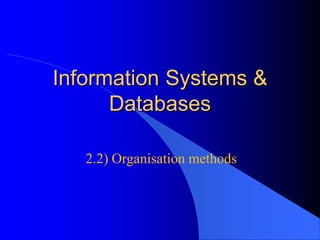
Database Organisation Methods
- 1. Information Systems & Databases 2.2) Organisation methods
- 2. • A database is an organised collection of data. • Non-computerised databases include: • telephone book • address book • recipe cards
- 3. • Advantages of non-computerised databases: • no power required • no training required • inexpensive • data not a linked security risk • Advantages of computerised databases: • easily edited • large storage • fast retrieval • display options
- 4. • A flat file database organises data into a single table. • Flat file databases organise the data into: • files – a block of data; divided into records and fields • record – a collection of facts about one specific entry • field – a specific category of data in a database • character – smallest unit of data (e.g. letters, numbers, symbols)
- 5. • Keys are fields that are used to sort and retrieve information. • Keys include: • single key – derived from one field • composite key – made by joining two or more keys together • primary key – a field that has a set of unique values • secondary key – a field that does not contain unique data
- 6. • A relational database organises data into a series of linked (related) tables. • The organisation of data in a relational database involves a schema. • A schema is the data definition for a relational database. • It shows the entities, relationships and attributes.
- 7. • An entity is the specific thing about which the data has been collected. • E.g. in school – student contact details, merits/demerits, reports, attendance. • Each table is one entity. • An attribute is a defined property of an entity. • Attributes are the same as fields in flat file databases.
- 8. • A relationship is the way in which entities are related to each other. • Entities are related through primary keys. • Entities can be related in one of three ways: • one to one • one to many • many to many
- 9. • Data modelling is the process of identifying entities, their attributes and the relationships between those entities through certain attributes. • Some tools that are used include: • data dictionaries • schematic diagrams • normalisation • Data dictionaries are comprehensive descriptions of each attribute.
- 10. • Each data dictionary contains metadata such as: • field name – should be short, clear and unambiguous • data type – kind of data (text, number, date, time, logical (Boolean)) • field size – number of characters allowed in an attribute • description – specifies the contents of an attribute
- 11. • The data dictionary is the basis for database creation. • If there are multiple designers it allows them to see if a particular attribute already exists in another entity. • This can help to eliminate data redundancy, which is the undesirable duplication of data within a database. [p.52 – Complete learning activity 4, parts (a) & (b) ]
- 12. • Schematic diagrams are graphical tools that help define the database and describe a schema. • An entity-relationship diagram (ERD) is a graphical method of identifying the entities and their attributes and showing the relationships between entities. [Draw Diagram 2.13, p.48]
- 13. • Hypermedia is a combination of media whose locations are linked electronically. • The information is stored using a set of documents that may contain: • text • images • video • audio • animations • executable files
- 14. • Information is retrieved using hypertext. • Hypertext is the system that allows documents to be cross-linked in such a way. • A link, or hyperlink, is usually indicated by a highlighted item. • One application of hypermedia is the World Wide Web. • Each document is accessed through its uniform resource locator.
- 15. • A URL is the address of a file or resource on the Web. • It links to an Internet Protocol (IP) number and is unique. • The URL consists of three parts: • protocol (http, https, ftp) • domain name – address of a specific computer where the website is hosted • file path – links to a specific page or resource.
- 16. • URL’s must be exact and complete or they will not work. • A storyboard is a series of frames, each representing a different action or image. • It is a tool used by hypermedia. • They consist of navigation paths, information and graphics. • They are popular because they are easy to read and modify.
- 17. • Four main storyboard layouts are: • linear – simple sequential path • hierarchical – branching top- down design • non-linear – no structure • combination – a blending of the above • Web pages are created using hypertext markup language (HTML).
- 18. • HTML is a set of special instructions that describe how the parts of a document are displayed. • They are actually text files with special HTML instructions. • An HTML editor is a program that specialises in writing HTML code. • Instructions are given using HTML tags. • These tags are metadata because they are information about the data.
- 19. • Links are achieved though text or images using specialised HTML tags. • Tags are usually paired to start and end an instruction. • E.g. <B> and </B> will make all text between them bold.